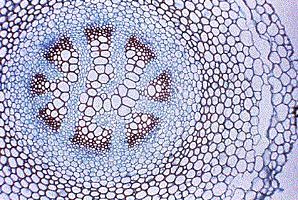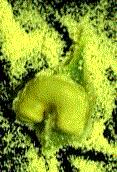



Lycophyta: More on Morphology





A cross section of a member of the order Lycopodiales is shown above. You can see the large red xylem cells because they have been stained with a chemical which sticks to the lignin in the cell walls of that tissue. Notice that there are other kinds of tissues among the xylem. This is only one way in which the vascular tissue of lycophyte stems may be arranged. Other lycophytes have a siphonostele, with a central region of generalized tissue within a cylinder of vascular tissue. The pattern of vascular tissues may even change during the course of development.
The first vascular plants branched dichotomously, in the same way that the living plant Psilotum branches. Many living lycophytes still branch this way, but several grow pseudomonopodially, such that one of the two forks of the branch is larger, and the other appears as a smaller side-branch to this main axis. This is the pattern most familiar to you, and which occurs in most living plants.
The current hypothesis for the origin of microphylls is called the enation theory, based on the idea that microphylls evolved through the vascularization of enations on the plant. The earliest vascular plants had no leaves; they produced clusters of photosynthetic stems without appendages. Some of these developed enations, or flaps of tissue, on their surface to increase the area over which gas-exchange and photosynthesis could occur. Later, some of these began to extend the vascular tissue of their stems toward these enations, possibly in response to increased photosynthetic activity there. The extension of the vascular system into the flaps of tissue creates a true leaf, in this case a microphyll.
The arrangement of leaves depends very much on the particular lycophyte in question. Many club mosses have leaves which are attached in a spiral pattern, while in other creeping species the leaves are all oriented in the same plane. In some, the leaves are fused to the stem, giving them the appearance of tiny junipers.

Lycophyte sporangia are stalked and kidney-shaped, as in the zosterophyllophytes. In the earliest lycophyte groups, such as the Asteroxylales, the sporangia are oriented across the leaf, so that the widest dimension of the sporangium is perpendicular to the axis of the leaf. In later groups, such as the Lepidodendrales and Isoetales, the sporangia are oriented along the axis of the leaf, and are sometimes embedded within the leaf rather than resting atop a short stalk.
While many lycophytes have their sporophylls scttered along their stem, most produce them in a strobilus, a cone-like structure consisting of many spore-producing leaves growing together in a tight cluster. A strobilus then, consists of a central stalk with sporophylls attached all around. In addition, there is a large group of lycophytes which are heterosporous, producing two kinds of spore, each of which will give rise to a single-sex gametophyte. Heterospory has also evolved independently in the ferns and seed plants.


